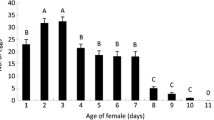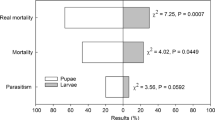Abstract
Microplitis bicoloratus Chen (Hymenoptera:Braconidae:Microgastrinae), a new species of Microplitis Förster from China, is a solitary endoparasitoid of the larvae of the cotton leafworm, Spodoptera litura (Fabricius) (Lepidoptera: Noctuidae). This parasitoid is the first to be successfully reared and evaluated in the laboratory as a potential agent for the biological control of S. litura in China. Oviposition, immature development, and the effects of parasitism on the development of S. litura were studied. In long-term oviposition trials, females laid eggs on S. litura larvae for up to 10 days; oviposition was heavily skewed toward the first few days, with approximately one third of the eggs laid on day 1 and over 50% laid by day 3. This rapid oviposition rate increases the potential for biological suppression of host populations because the likelihood of mortality for the parasites from exposure to detrimental environmental factors or generalist predators increases with time. Immature development of the parasitoid in its host only required 7 days: eggs hatched within 24 h, the first instar larva required 2 days, the second instar larva needed 3 days, and the third instar larvae exited the host and pupated in 1 day, at 27±1°C, 60–80% relative humidity and a 12:12-h (long day) photoperiod. The development of the parasitized hosts was disrupted. When the parasitoid larvae finished development, the body weights of host larvae were significantly reduced regardless of which host instar was parasitized. Our results suggest that M. bicoloratus has considerable potential as a biological control agent for S. litura.
Similar content being viewed by others
References
Beckage N.S., (1998). Modulation of immune responses to parasitoids by polydnavirus. Parasitology 116[Suppl]: S57–S64
Beckage N.S., Gelman D.B., (2004). Wasp parasitoid disruption of host development: Implications for new biologically based strategies for insect control. Annu. Rev. Entomol. 49:299–330
Bonning B.C., Hammock B.C., (1996). Development of recombinant baculovirused for insect control. Annu. Rev. Entomol. 41:191–210
Chapman R.F., (1975). The insects, structure and function. Elsevier, New York
Chen J.H., Ji Q.E., Song D.B., (2004). A new species of Microplitis Förster from China (Hymenoptera: Braconidae: Microgastrinae). Entomotog. J. East China 13: 1–5
Chen Q.J., Pang Y., Li G.H., (1998). Spopdoptera litura nucleopolyhedrovirus insecticide: Chongwen-I. J. Wuhan Univ. 44: 183
Dahlman D.L., Vinson S.B., (1993). Teratocytes: developmental and biochemical characteristics. In: Beckage N.E., Thompson S.N., Federici B.A. (eds) Parasites and pathogens of insects, vol. 1. Academic Press, San Diego, pp. 145–165
Gauld I.D., Hanson P.E., (1995). Life history strategy: idiobionts and koinobionts. In: Quicke D.L.J. (eds) Parasitic wasps. Cambridge University Press, Cambridge, pp. 68–71
Grossniklaus-Bürgin C., Wyler T., Pfister-Wilhelm R., Lanzrein B., (1994). Biology and morphology of the parasitoid Chelonus inanitus (Braconidae, Hymenoptera) and effects on the development of its host Spodoptera littoralis (Noctuidae, Lepidoptera). Invertebr. Reprod. Dev. 25: 143–158
Hegazi E.M., Furhrer E., (1985). Instars of Microplitis rufiventris (Hym: Braconidae) and their relative developmental speed under different photoperiods. Entomophaga 30:231–243
Lawrence P.O., (1986). Host-parasite hormonal interactions: an overview. J. Insect Physiol. 32: 298–298
Li G.H., Chen Q.J., Pang Y., (1998). Studies of artificial diets for the beet armyworm, Spodoptera exigua. Acta Sci. Nat. Univ. Sun Yat-Sen 4: 1–5
Luo K.J., Gu D.X., Zhang G.R., Cheng Z.Q., (2004). Parasitoids of four noctuidae pests in cruciferous vegetable. Chin. J. Biol. Control 20: 211–214
Luo K.J., Gu D.X., Zhang G.R., Cheng Z.Q., (2005). Ovary structures of two parasitic wasps Microplitis bicoloratus and Diglyhus isaea. Entomol. Knowledge 42: 69–70
Muniappan R., Bamba J., Cruz J., Reddy G.V.P., (2004). Biology, rearing and field release on Guam of Euplectrus maternus, a parasitoid of the fruit-piercing moth, Eudocima fullonia. BioControl 49: 537–551
Pang Y., (1994). Viral diseases. In: Pu Z.L. (eds) Insect pathology. Guangdong Science and Technology Press, Guangzhou, pp. 85–216
Pang Y., (1998). Study and application of insect pathogens. In: Bao J.Z., Gu D.X. (eds) Biological control in China. Shanxi Science and Technology Press, Taiyuan, pp. 368–494
Pang Y., Hu Zh.H., Yang K., (2001). Recombinant baculoviruses. In: Huang D.F., Lin M. (eds) Agricultural microbes. Science and Engineered Technology Press, Beijing,, pp. 271–315
Pringle J.H.W., (1938). Proprioception in insects. J. Exp. Biol. 15: 101–103
Rana R.L., Dahlman D.L., Webb B.A., (2002). Expression and characterization of a novel teratocyte protein of the Branconid, Microplitis croceipes (Cresson). Insect Biochem. Mol. Biol. 32: 1507–1516
Rocha K.L., Mangine T., Harris E.J., Lawrence P.O., (2004). Immature stages of Fopius arisanus (Hymenoptera: Braconidae) in Bactrocera dorsalis (Diptera: Tephritidae). Fla. Entomol. 87: 164–168
Smits P.H., van Velden M.C., van de Vrie M., Vlak J.M., (1987). Feeding and dispersion of Spodoptera exigua larvae and its relevance for control with a nuclear polyhedrosis virus. Entomol. Exp. Appl. 43: 67–72
SPSS Inc., (2003). SPSS 12.0 for Windows, user’s guide. SPSS Inc., Chicago
SuperANOVA, 1991. Abacus concepts. Berkeley, Calif.
Zhang M., Chadhuri S.K., Kubo I., (1993). Quantification of insect growth and its use in screening of naturally occurring insect control agents. J. Chem. Ecol. 19: 1109–1118
Acknowledgements
This research was supported by the National Major Basic Research Project (‘973’) of China (G2000016209) and Open-funding of the State Key Laboratory of Biocontrol in Sun Yat-sen University (0404). The authors gratefully acknowledge Dr. Jiahua Chen for his help with the identification of the wasp.
Author information
Authors and Affiliations
Corresponding author
Rights and permissions
About this article
Cite this article
Luo, K., Trumble, J.T. & Pang, Y. Development of Microplitis bicoloratus on Spodoptera litura and implications for biological control. BioControl 52, 309–321 (2007). https://doi.org/10.1007/s10526-006-9030-8
Received:
Accepted:
Published:
Issue Date:
DOI: https://doi.org/10.1007/s10526-006-9030-8




